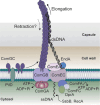Gram-Positive Type IV Pili and Competence
- PMID: 30737914
- PMCID: PMC11588153
- DOI: 10.1128/microbiolspec.PSIB-0011-2018
Gram-Positive Type IV Pili and Competence
Abstract
Type IV pili (T4P) are remarkable bacterial surface appendages that carry out a range of functions. Various types of T4P have been identified in bacteria and archaea, making them almost universal structures in prokaryotes. T4P are best characterized in Gram-negative bacteria, in which pilus biogenesis and T4P-mediated functions have been studied for decades. Recent advances in microbial whole-genome sequencing have provided ample evidence for the existence of T4P also in many Gram-positive species. However, comparatively little is known, and T4P in Gram-positive bacteria are just beginning to be dissected. So far, they have mainly been studied in Clostridium and Streptococcus spp. and are involved in diverse cellular processes such as adhesion, motility, and horizontal gene transfer. Here we summarize the current understanding of T4P in Gram-positive species and their functions, with particular focus on the type IV competence pilus produced by the human pathogen Streptococcus pneumoniae and its role in natural transformation.
Figures


References
MeSH terms
Substances
LinkOut - more resources
Full Text Sources
Molecular Biology Databases
Miscellaneous

